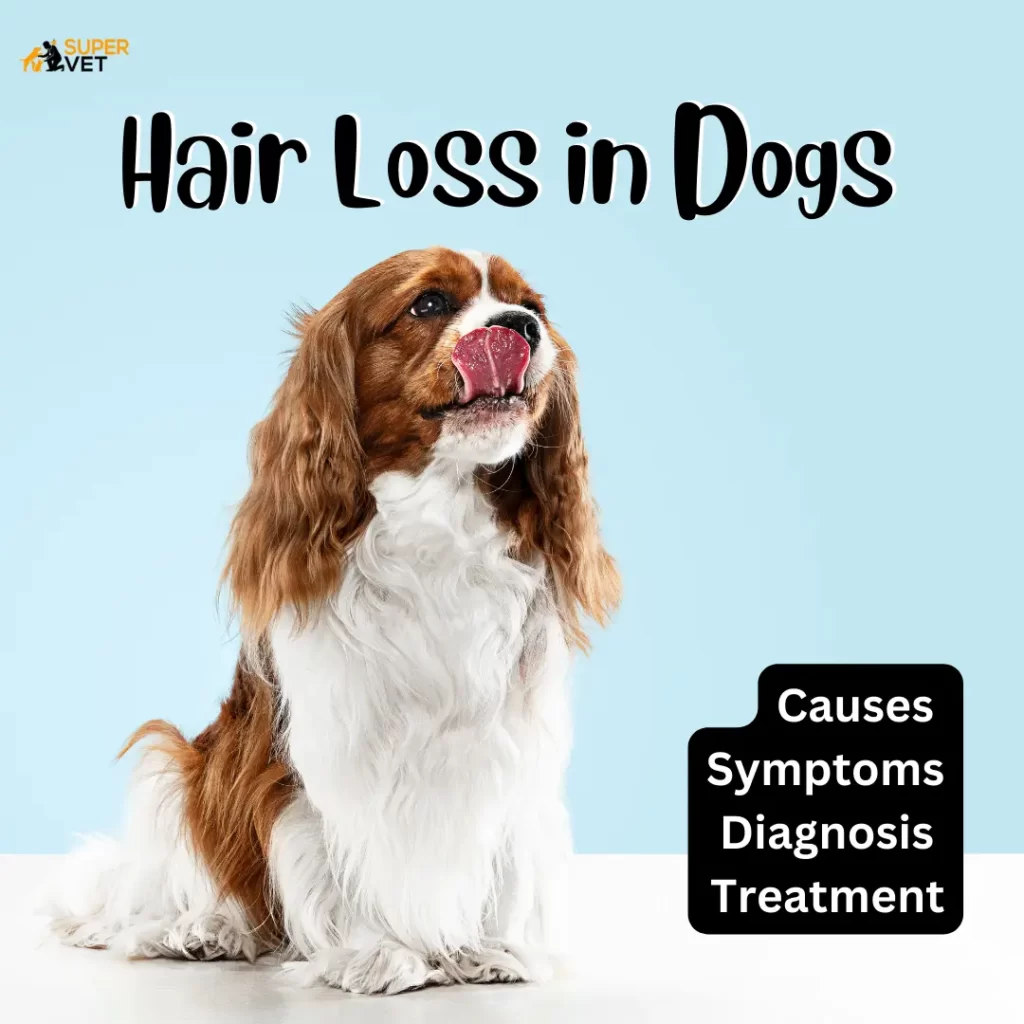A blog post on Hair fall in Dogs.
If you’re noticing that your dog is losing more fur than usual, you might be wondering what’s going on.
A dog’s coat is one of the first things you notice about them. It can be a source of comfort, as well as a key part of their identity.
Hair loss in dogs is a common problem that can have many different causes. Genetics, allergies, hormonal imbalance, and even stress can lead to hair loss in dogs.
While hair loss is often not a serious medical condition, it can be very upsetting for both the dog and the owner. If you are dealing with hair loss in your dog, there are a few things you can do to help ease the shedding and regrow the lost fur.
In this blog post, we’ll discuss some of the most common Symptoms, and causes of hair loss in dogs as well as some possible treatments.
Symptoms of Hair fall in Dog
Before determining whether your dog has hair loss or not, you need to look for some signs and symptoms that occur to him.
It is very common for Dogs to lose their Hair and can happen at any age, in any breed, and in any part of the body. There are varieties of symptoms that may develop depending on the underlying cause:
- Thinning of hair
- Red and inflamed skin around the area of hair loss indicates infection.
- Hair loss near the eyes and mouth
- Oozing of moisture, blood, or pus around the area of hair loss(Secondary condition of Infection)
- Patches of complete hair loss
- Foul-smelling skin
- Symmetrical patterns of hair loss on both sides of the body
- Constant Itchiness
- Black or dark grey skin around the area of hair loss
- Dry, scaly skin under the area of hair loss
Cause of Hair fall in Dog

Dog owners may be alarmed to find their beloved pet is losing hair. Hair loss in dogs can have many causes, including allergies, parasites, and hormonal problems. Being able to identify the cause of your dog’s hair loss is important in getting them the proper treatment they need.
There are maybe following different reasons why your furry friend’s coat may be thinning out-
- Genetics (some breeds have hair loss in adulthood on ears, chest, thighs, or in certain parts of the body)
- Sex hormone imbalance (often seen in older)
- Trauma and/or scarring
- Post-surgical clipping
- Infection (bacterial or fungal)
- Ringworm (fungal infection,
- Parasites (such as fleas or mites)
- Allergies (caused by environmental factors or certain foods/ingredients)
- Chemotherapy
- Pressure sores
- Skin cancer
- Thyroid disorder
- Cushing’s disease
- Friction (from a neckband)
- Nervous chewing or licking
Diagnosis of Hair Loss in Dogs
If your dog is starting to thin out on top, it may be more than just a change in the seasons. Hair loss can be a sign of an underlying medical condition in dogs. While not all hair loss is cause for concern, it’s important to be aware of the potential causes and seek veterinary care if your dog is suddenly losing fur.
Diagnosis of hair fall is based on the following signs:-
- The pattern of hair loss – If your dog has Generalized hair loss that could be an indication of bacterial infection. Infection can occur because of ringworm, bacterial infection, mites, or mange.
Due to a flea allergy, there is hair loss in the area of the buttocks and tail. Hair loss from the paws and face indicates environmental allergy (atopy). (Endocrine disorders) Symmetrical hair loss due to adrenal gland disorder, abnormal sex hormone levels, thyroid disorder, and other disorders.
- Skin impression spots – Press the microscopic slide on the infected to show the presence of bacteria, yeast, or other infectious elements and analyze it.
- Blood Test – assist to analyze certain immune system conditions, Cushing’s disorder, and Diabetes mellitus, hormone irregularities, thyroid diseases.
- Luminescence – Some ringworm species will illuminate a fluorescent green-yellow underneath UV light.
- Biopsy – Send a sample of the infected area to the laboratory to analyze (If skin cancer or a tumor) diagnosis and treatment.
- Skin scraping – The gathering of hair follicles onto a slide by skin scrapping can help detect the presence of mange mites.
- Allergy testing
Treatment of Hair Loss in Dogs

If you are dealing with hair loss in your dog, there are a few things you can do to help ease the shedding and regrow the lost fur.
Counting on the diagnosis, there are different types of treatments are available for dog hair loss.
- Antibiotics (oral or topical) for bacterial infections.
- Antifungals (oral or topical) for treating ringworm and yeast infections.
- Steroids
- Immunosuppressive Drugs or Anti-cytokine Drugs for controlling environmental allergy (Atopy).
- Immunotherapy for allergy desensitization.
- Behavioral medications
- Medicated shampoos
- Hypoallergenic diets (solve hair loss due to food allergies)
- Monthly flea preventatives
- Thyroid prescription and hormone therapy
- Vitamin E, Vitamin A, and fish oil supplements
- E-collar or cone prevents your pet from licking the affected area until cured.
- The surgery is required to remove sections of skin cancer or tumors.
- Neutering or spaying is required for sex-hormone disorders.
Parting Words
For Hair loss, your dog may need to treat more than once relying on your vet’s prescription for skin infections. Observe your dog’s skin and coat regrowth. Share any differences with the veterinarian so they can modify treatment and medicine accordingly.

